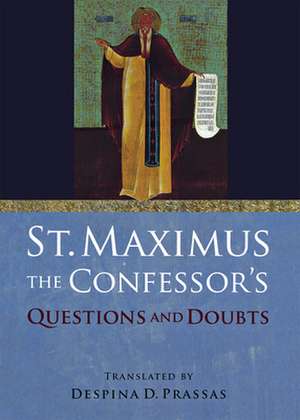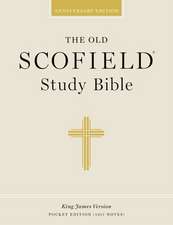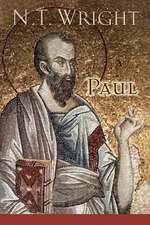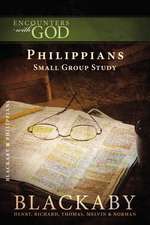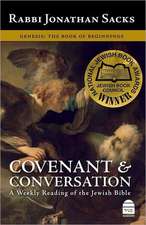St. Maximus the Confessor's Questions and Doubts
Autor St. Maximus Editat de Despina D. Prassasen Limba Engleză Hardback – 9 sep 2009
Maximus the Confessor (580–662) was a monk whose writings focused on ascetical interpretations of biblical and patristic works. For his refusal to accept the Monothelite position supported by Emperor Constans II, he was tried as a heretic, his right hand was cut off, and his tongue was cut out. A major theologian of the Byzantine Church, St. Maximus is venerated in both Eastern and Western Christian traditions. Despina Prassas’s translation of the Quaestiones et Dubia presents for the first time in English one of the Confessor’s most significant contributions to early Christian biblical interpretation.
The original work is believed to have been written before 626 while the monk was a member of a community located near Constantinople. The text is a series of 239 interrogations and responses addressing theological, philosophical, ascetical, spiritual, and liturgical concerns. In his work, Maximus the Confessor brings together the patristic exegetical aporiai tradition and the spiritual-pedagogical tradition of monastic questions and responses. The overarching theme is the importance of the ascetical life. For Maximus, askesis is a lifelong endeavor that consists of the struggle and discipline to maintain control over the passions. One engages in the ascetical life by taking part in both theoria (contemplation) and praxis (action). To convey this teaching, Maximus uses a number of pedagogical tools including allegory, etymology, number symbolism, and military terminology.
Prassas provides a rich historical and contextual background in her introduction to help ground and familiarize the reader with this work. As the first study focused exclusively on the Quaestiones et dubia, this important book will appeal to the growing audience of readers interested in Maximus the Confessor and, more broadly, to scholars and students of early Christianity, early Byzantine monasticism, and patristic biblical exegesis.
The original work is believed to have been written before 626 while the monk was a member of a community located near Constantinople. The text is a series of 239 interrogations and responses addressing theological, philosophical, ascetical, spiritual, and liturgical concerns. In his work, Maximus the Confessor brings together the patristic exegetical aporiai tradition and the spiritual-pedagogical tradition of monastic questions and responses. The overarching theme is the importance of the ascetical life. For Maximus, askesis is a lifelong endeavor that consists of the struggle and discipline to maintain control over the passions. One engages in the ascetical life by taking part in both theoria (contemplation) and praxis (action). To convey this teaching, Maximus uses a number of pedagogical tools including allegory, etymology, number symbolism, and military terminology.
Prassas provides a rich historical and contextual background in her introduction to help ground and familiarize the reader with this work. As the first study focused exclusively on the Quaestiones et dubia, this important book will appeal to the growing audience of readers interested in Maximus the Confessor and, more broadly, to scholars and students of early Christianity, early Byzantine monasticism, and patristic biblical exegesis.
Preț: 369.97 lei
Nou
Puncte Express: 555
Preț estimativ în valută:
70.81€ • 76.44$ • 59.37£
70.81€ • 76.44$ • 59.37£
Carte tipărită la comandă
Livrare economică 19 aprilie-03 mai
Preluare comenzi: 021 569.72.76
Specificații
ISBN-13: 9780875804132
ISBN-10: 0875804136
Pagini: 234
Dimensiuni: 140 x 216 x 23 mm
Greutate: 0.43 kg
Ediția:1
Editura: Northern Illinois University Press
Colecția Northern Illinois University Press
ISBN-10: 0875804136
Pagini: 234
Dimensiuni: 140 x 216 x 23 mm
Greutate: 0.43 kg
Ediția:1
Editura: Northern Illinois University Press
Colecția Northern Illinois University Press
Recenzii
"An excellent and timely piece of work. A very important contribution to the continuing renaissance of work on Maximus the Confessor. More importantly, there is no antecedent English tranlsation of this important work; such is long overdue."-Paul Blowers, Emmanuel School of Religion, author of Exegesis and Spiritual Pedagogy in Maximus the Confessor
Notă biografică
Despina D. Prassas is an Associate Professor of Theology at Providence College, in Providence, RI. Her research areas include Greek patristics and ecumenical theology.
Cuprins
Table of Contents
Acknowledgments
Introduction
- Historical and Cultural Context
- Maximus and the Quaestiones et dubia
- Translator’s Note
St. Maximus the Confessor’s Quaestiones et dubiaTranslation
Abbreviations and References
Notes
Bibliography
Index
Introduction
- Historical and Cultural Context
- Maximus and the Quaestiones et dubia
- Translator’s Note
St. Maximus the Confessor’s Quaestiones et dubiaTranslation
Abbreviations and References
Notes
Bibliography
Index
Descriere
Maximus the Confessor (580–662) was a monk whose writings focused on ascetical interpretations of biblical and patristic works. For his refusal to accept the Monothelite position supported by Emperor Constans II, he was tried as a heretic, his right hand was cut off, and his tongue was cut out. A major theologian of the Byzantine Church, St. Maximus is venerated in both Eastern and Western Christian traditions. Despina Prassas’s translation of the Quaestiones et Dubia presents for the first time in English one of the Confessor’s most significant contributions to early Christian biblical interpretation.
The original work is believed to have been written before 626 while the monk was a member of a community located near Constantinople. The text is a series of 239 interrogations and responses addressing theological, philosophical, ascetical, spiritual, and liturgical concerns. In his work, Maximus the Confessor brings together the patristic exegetical aporiai tradition and the spiritual-pedagogical tradition of monastic questions and responses. The overarching theme is the importance of the ascetical life. For Maximus, askesis is a lifelong endeavor that consists of the struggle and discipline to maintain control over the passions. One engages in the ascetical life by taking part in both theoria (contemplation) and praxis (action). To convey this teaching, Maximus uses a number of pedagogical tools including allegory, etymology, number symbolism, and military terminology.
Prassas provides a rich historical and contextual background in her introduction to help ground and familiarize the reader with this work. As the first study focused exclusively on the Quaestiones et dubia, this important book will appeal to the growing audience of readers interested in Maximus the Confessor and, more broadly, to scholars and students of early Christianity, early Byzantine monasticism, and patristic biblical exegesis.
The original work is believed to have been written before 626 while the monk was a member of a community located near Constantinople. The text is a series of 239 interrogations and responses addressing theological, philosophical, ascetical, spiritual, and liturgical concerns. In his work, Maximus the Confessor brings together the patristic exegetical aporiai tradition and the spiritual-pedagogical tradition of monastic questions and responses. The overarching theme is the importance of the ascetical life. For Maximus, askesis is a lifelong endeavor that consists of the struggle and discipline to maintain control over the passions. One engages in the ascetical life by taking part in both theoria (contemplation) and praxis (action). To convey this teaching, Maximus uses a number of pedagogical tools including allegory, etymology, number symbolism, and military terminology.
Prassas provides a rich historical and contextual background in her introduction to help ground and familiarize the reader with this work. As the first study focused exclusively on the Quaestiones et dubia, this important book will appeal to the growing audience of readers interested in Maximus the Confessor and, more broadly, to scholars and students of early Christianity, early Byzantine monasticism, and patristic biblical exegesis.
